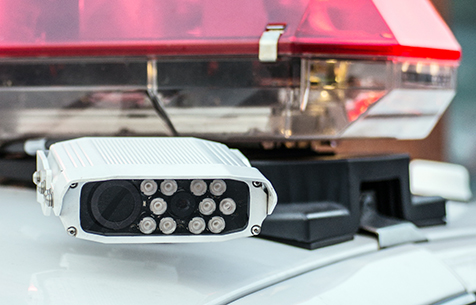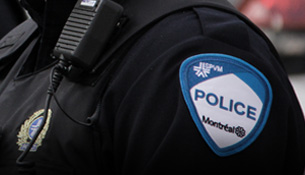
User process on the automated licence plate reader (ALPR) system
The SPVM has 30 patrol vehicles fitted with an ALPR system in its territory. This technology is comprised of two cameras installed on the roof of the patrol vehicle. When the system is operational, it can read vehicle licence plates passing the camera’s field of view.
ALPR checks are carried out in several databases which are updated by:
- Société de l'assurance automobile du Québec (SAAQ)
- Canadian Police Information Centre (CPIC)
- SPVM based on operational needs (e.g., AMBER alert, missing person, vehicle of interest)
The licence plate numbers read by the ALPR system are compared with the numbers in the database. When the ALPR system identifies a match, the system sounds an audible alert and displays the photograph of the vehicle (rear view). When the alert is received, the patrol officer does not know the exact nature of the alert. The police officer must carry out a vehicle check with the Québec Police Intelligence Centre (QPIC).
The user of the ALPR system does not have access to the data history recorded by the ALPR system and cannot carry out a search at his or her level to retrieve licence plates captured in the past.
Use of these cameras forms part of all initiatives implemented by the SPVM to improve road safety. In this respect, this system aims to:
- Encourage observance of the Highway Safety Code;
- Increase the number of drivers who comply and pay their driver and vehicle licence;
- Improve the effectiveness and efficiency of police work on cases of missing or wanted persons (AMBER alert) or to locate stolen vehicles.
Statistics on use of the ALPR system will be included in SPVM’s annual report as from 2020.
Data protection and operating of the system
Step 1. Data transfer from SAAQ and QPIC
Data received is stored in a secure directory in a SPVM environment. Only users with privileged access who have undergone a judicial investigation process have access to this data.
Step 2. Transfer to the ALPR system in the patrol vehicle
Data processed and encrypted on our server is transferred to the 30 patrol vehicles fitted with the ALPR system. The system uses a data transfer algorithm to protect data.
Step 3. Procedure to be followed by the police officer using the ALPR system
The police officer logs into the system using a unique username and password. The vehicle system produces alerts via the cameras by comparing licence plate data with the three sources of data mentioned (SAAQ, QPIC and SPVM).
After an alert, the police officer checks if the data provided by the ALPR system is correct by carrying out a check with the QPIC. When the police officer finishes using the ALPR system, he or she closes his or her user session and the data on readings and alerts is sent to the servers. Data is systematically deleted from the patrol vehicle system.
Management of collected data
The security measures in force at SPVM ensure the protection, integrity and confidentiality of data by limiting access to its employees on a need-to-know basis in the performance of their duties. Only two SPVM police officers have been granted access to conduct searches in ALPR system data. Data access enables ALPR usage reports to be created.
All data obtained by the SPVM is protected in compliance with laws, regulations, policies and guidelines on confidentiality and security of information.
Data on readings obtained is stored for five years. Data is then automatically deleted by the system.
Question - Answers
1. How can you guarantee that personal information on residents collected by this system is protected?
Only information collected in the database of the automated licence plate reader system is the licence plate, GPS coordinates for the place where the plate was read and the details of the police officers on board this vehicle. No personal information, such as the resident’s address, is found in the database.
2. Is it possible for a resident to receive a fine by mail after the ALPR system reads his or her licence plate?
Yes, but only on an exceptional basis like for any other statement of offence.
The ALPR system is a tool which is used to notify police officers when a vehicle passing the camera's field of view (or the owner of this vehicle) is not in compliance. It does not change the procedures for stopping vehicles or issuing statements of offence. As usual, the police officer will carry out a licence plate check and then, if appropriate, immediately speak to the driver.
3. Does this project not breach residents’ privacy?
This system does not collect any personal information on drivers. The automated licence plate reader system is only used to support police officers perform their day-to-day duties.
4. What are the benefits of such a project for residents?
The automated licence plate reader system helps police officers to quickly identify certain types of drivers committing offences and ensure safety for drivers.
The SPVM will be able to identify more quickly a missing person or a vehicle involved in an AMBER alert. For example, when a person is reported missing, the licence number of his or her vehicle will be added to the database for the 30 vehicles. If one of these patrol vehicles captures the licence plate of the wanted vehicle, the police officer will immediately be notified.
5. What will the SPVM do with the video recorded by this system?
The automated licence plate reader system does not aim to use a video. The ALPR system cameras are only used to read and identify vehicle licence plate numbers. A photograph of the rear of the vehicle detected by the system in its environment will be displayed on the screen to help the police officer quickly identify the vehicle.
The confidentiality of these images is obviously a priority for the Service de police de la Ville de Montréal.
6. Does this project aim to issue more fines to residents to fill your quotas?
This system aims to improve detection of vehicles which are not authorized to circulate due among other reasons to the driver’s licence holder failing to pay his or her licence, driving with a suspended licence, having been found guilty of driving while impaired by alcohol or dangerous driving.
The ALPR system is primarily a tool aimed at protecting the safety of road users and is also used to improve SPVM’s road safety record.



